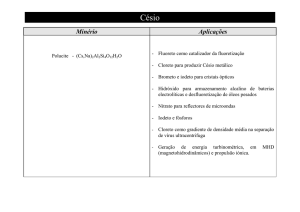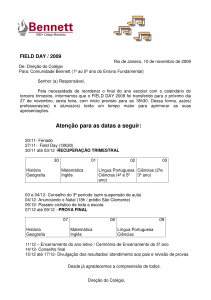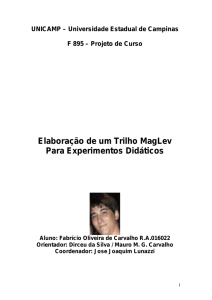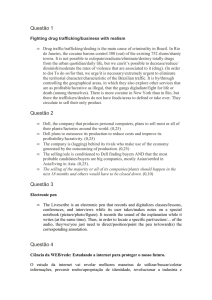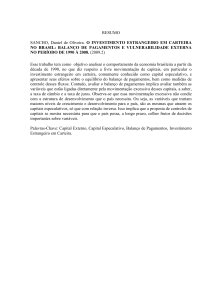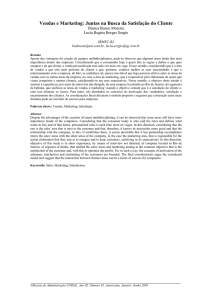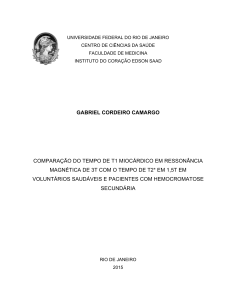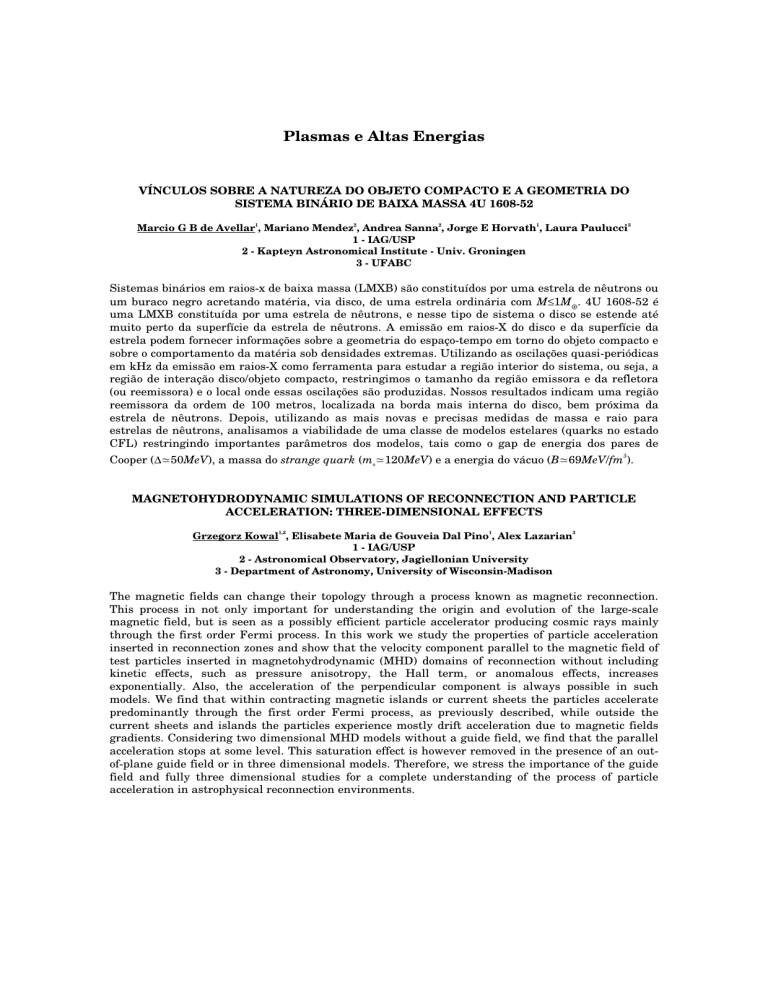
Plasmas e Altas Energias
VÍNCULOS SOBRE A NATUREZA DO OBJETO COMPACTO E A GEOMETRIA DO
SISTEMA BINÁRIO DE BAIXA MASSA 4U 1608-52
Marcio G B de Avellar1, Mariano Mendez2, Andrea Sanna2, Jorge E Horvath1, Laura Paulucci3
1 - IAG/USP
2 - Kapteyn Astronomical Institute - Univ. Groningen
3 - UFABC
Sistemas binários em raios-x de baixa massa (LMXB) são constituídos por uma estrela de nêutrons ou
um buraco negro acretando matéria, via disco, de uma estrela ordinária com M≤1M. 4U 1608-52 é
uma LMXB constituída por uma estrela de nêutrons, e nesse tipo de sistema o disco se estende até
muito perto da superfície da estrela de nêutrons. A emissão em raios-X do disco e da superfície da
estrela podem fornecer informações sobre a geometria do espaço-tempo em torno do objeto compacto e
sobre o comportamento da matéria sob densidades extremas. Utilizando as oscilações quasi-periódicas
em kHz da emissão em raios-X como ferramenta para estudar a região interior do sistema, ou seja, a
região de interação disco/objeto compacto, restringimos o tamanho da região emissora e da refletora
(ou reemissora) e o local onde essas oscilações são produzidas. Nossos resultados indicam uma região
reemissora da ordem de 100 metros, localizada na borda mais interna do disco, bem próxima da
estrela de nêutrons. Depois, utilizando as mais novas e precisas medidas de massa e raio para
estrelas de nêutrons, analisamos a viabilidade de uma classe de modelos estelares (quarks no estado
CFL) restringindo importantes parâmetros dos modelos, tais como o gap de energia dos pares de
3
Cooper (∆≃50MeV), a massa do strange quark (ms≃120MeV) e a energia do vácuo (B≃69MeV/fm ).
MAGNETOHYDRODYNAMIC SIMULATIONS OF RECONNECTION AND PARTICLE
ACCELERATION: THREE-DIMENSIONAL EFFECTS
Grzegorz Kowal1,2, Elisabete Maria de Gouveia Dal Pino1, Alex Lazarian3
1 - IAG/USP
2 - Astronomical Observatory, Jagiellonian University
3 - Department of Astronomy, University of Wisconsin-Madison
The magnetic fields can change their topology through a process known as magnetic reconnection.
This process in not only important for understanding the origin and evolution of the large-scale
magnetic field, but is seen as a possibly efficient particle accelerator producing cosmic rays mainly
through the first order Fermi process. In this work we study the properties of particle acceleration
inserted in reconnection zones and show that the velocity component parallel to the magnetic field of
test particles inserted in magnetohydrodynamic (MHD) domains of reconnection without including
kinetic effects, such as pressure anisotropy, the Hall term, or anomalous effects, increases
exponentially. Also, the acceleration of the perpendicular component is always possible in such
models. We find that within contracting magnetic islands or current sheets the particles accelerate
predominantly through the first order Fermi process, as previously described, while outside the
current sheets and islands the particles experience mostly drift acceleration due to magnetic fields
gradients. Considering two dimensional MHD models without a guide field, we find that the parallel
acceleration stops at some level. This saturation effect is however removed in the presence of an outof-plane guide field or in three dimensional models. Therefore, we stress the importance of the guide
field and fully three dimensional studies for a complete understanding of the process of particle
acceleration in astrophysical reconnection environments.
SUPERTRANSIENT MAGNETOHYDRODYNAMIC TURBULENCE IN ACCRETION DISKS
Erico Luiz Rempel1,2, Geoffroy Lesur3, Michael R. E. Proctor4
1 - CTA/ITA
2 - CEA/INPE
3 - Laboratoire d’astrophysique Observatoire de Grenoble
4 - University of Cambridge - UK
Discos de acreção são estruturas formadas ao redor de objetos massivos devido à atração
gravitacional, estando ligados ao processo de formação de estrelas e planetas a partir de nuvens
moleculares. Como a matéria do disco se desloca seguindo órbitas Keplerianas, o momento angular
decai com a diminuição do raio r. Quando a matéria se desloca em direção ao centro do disco, a
conservação do momento angular requer que o excesso de momento seja transportado para fora.
Assim, o transporte de momento angular é um fenômeno crucial para o entendimento do sistema. Em
modelos matemáticos sem campos magnéticos e quando o cisalhamento é a única estratificação, os
discos de acreção Keplerianos são linearmente estáveis, o que significa que perturbações iniciais
decaem para um regime laminar. A taxa de acreção de massa no disco depende do transporte de
momento angular para fora do disco e a turbulência é uma das formas de se obter este transporte.
Contudo, experimentos numéricos e em laboratório têm revelado que o transporte turbulento de
momento angular em fluidos Keplerianos é muito baixo. Quando um campo magnético vertical é
aplicado, a instabilidade magnetorrotacional (MRI) fornece uma instabilidade linear que pode
resultar em uma forte turbulência magnetohidrodinâmica (MHD), capaz de gerar taxas adequadas de
transporte de momento angular. Se não houver um campo magnético de fundo imposto ao problema, o
campo original decai com o tempo devido à resistividade finita. Neste caso, algum tipo de dínamo nãolinear é necessário para amplificar e sustentar o campo original e manter a instabilidade. Neste
trabalho, investigamos a transição para turbulência em discos Keplerianos usando simulações locais
baseadas nas equações MHD incompressíveis com cisalhamento e verificamos que a turbulência
gerada decai com o tempo, sendo que o tempo de atuação da instabilidade MRI cresce como uma
função exponecial do número de Reynolds do escoamento.
SIMULATING THE EVOLUTION OF MAGNETIC FIELDS IN THE INTRA-CLUSTER AND
INTERGALACTIC MEDIUM USING A KINETIC MHD MODEL
Reinaldo Santos-Lima1, Elisabete Maria de Gouveia Dal Pino1, Maria Soledad Nakwacki1, Alex
Lazarian2,
1
Grzegorz Kowal , Diego Falceta-Golçalves3
1 - IAG/USP
2 - University of Wisconsin
3 - EACH/USP
Estimates based on observational data reveal that the gas of the intergalactic (IGM) and intra-cluster
medium (ICM) is weakly collisional. Therefore, using the standard magnetohydrodynamic (MHD)
model for describing these kind of environments is poorly justified. In collisionless plasmas, the
microscopic velocity distribution of the particles is not isotropic, and it gives rise to kinetic effects on
the dynamical scales. These kinetic effects can have important effects on the turbulence and structure
formation both in the IGM and ICM, as well as on the amplification and maintenance of the cosmic
magnetic fields. It is possible to formulate fluid models for collisonless or weakly collisional gas by
introducing modifications in the MHD equations. These models are often referred as kinetic MHD
(KMHD). Using a KMHD model based on the so called CGL-closure, which allows the adiabatic
evolution of the two components of the pressure tensor (i.e., the parallel and the perpendicular
components with respect to the local magnetic field), we performed 3D numerical simulations of
forced turbulence in the ICM in order to study the amplification of an initially weak seed magnetic
field. We have found that a necessary condition for the magnetic field amplification to work is to
impose limits to the anisotropy of the pressure. We have also found that the growth rate of the
magnetic energy by the turbulence is comparable to that of the ordinary MHD turbulent dynamo, but
the magnetic energy saturates at a level which is much smaller than that of the MHD case. In the
case of an isothermal KMHD approach the success of the turbulent dynamo amplification depends
critically on the regime of anisotropy. These results indicate that the amplification of magnetic fields
in the ICM and IGM by turbulence is very limited when kinetic effects are important. It remains to
study, however, the influence of the numerical resolution on these results.



